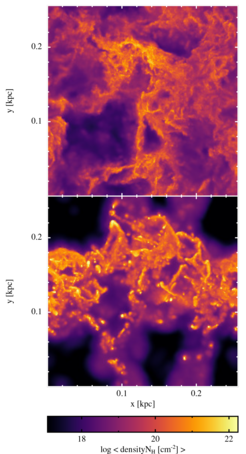Heat conduction in the Interstellar Medium
A team of researchers from the Max Planck Institute for Astrophysics, the University Observatory Munich, and collaborators have investigated the effect of heat conduction on the evolution of supernova blast waves and the structure of the supernova-driven interstellar medium (ISM). They find that thermal conduction has a strong impact on the volume filling fractions of cold, warm and hot gas. Thermal conduction also plays an important role for an accurate description of the hot ISM phase structure and the chemical composition of the cold phase of the turbulent ISM.

Figure 1: Column density of neutral hydrogen with (top) and without (bottom) thermal conduction for a patch of the SN-driven ISM. In both cases the hot phase is dominating the volume with higher fractions for the simulations with thermal conduction.
Thermal conduction is a fundamental physical process describing heat transport along a temperature gradient. The impact of this effect is measured by the conductivity constant. For every material on Earth the conductivity constant describes how efficiently it transports thermal energy. Iron, for example, has a very high conductivity and is very efficient in transporting heat since the electrons can move freely through the whole domain with only minimal losses due to interactions with atoms.
However, the situation in the ISM is very different. It is composed of very cold and dense regions with a lot of mass but covering little volume. The majority of the volume of the ISM is in the warm and hot phases at lower densities. The conductivity depends on the temperature itself and changes significantly over several orders of magnitude within the ISM. In the absence of any other process, however, thermal conduction alone can change the ISM structure, for example by evaporating cold clouds embedded in a hot medium.
A team of researchers from the Max Planck Institute for Astrophysics, the University Observatory in Munich, the University of Cologne and the Center for Computational Astrophysics in New York has investigated how heat conduction can change the properties of the supernova-driven ISM. Supernova explosions at the end of the life of massive stars are one of the most important feedback processes in the ISM driving turbulence and restoring the hot phase of the ISM.
The team has performed detailed resolution tests of individual supernovae exploding at various ambient densities, simultaneously following the chemical evolution and non-equilibrium low temperature cooling. Based on these results, the impact of thermal conduction on the structure of the ISM has been simulated in high-resolution, periodic ISM boxes with solar neighborhood conditions and supernova rates. A multi-phase ISM is developing rapidly in all cases. However, the total volume filled by the hot phase changes strongly from 30 to 40 per cent in the absence of thermal conduction to 70 – 80 per cent in the presence of thermal conduction, also resulting in a differently structured morphology (Fig. 1).

Why is the impact so strong? Thermal conduction is a physical process, which can redistribute thermal energy within the ISM from hot to colder gas. Due to the conservation of energy this leads to a mass flux from colder to warmer gas, which increases the mass of the hot phase and also its volume.
Heat conduction not only influences the hot phase of the ISM, it also changes the physical properties of the cold phase. The conductivity constant is smaller at lower temperatures and the cooling times in this regime are much shorter (a few hundred to thousand years).There is still energy transport from the warm phase towards the cold regime but due to the short cooling times it is directly ‘cooled’ away and the mass flux from the cold to the warm phase is suppressed. Therefore, the researchers find less mass in the warm phase of the ISM and more in the cold phase in the runs with thermal conduction (Fig. 2). Thermal conduction leads to an extended high-density tail with maximum densities that can be a factor of 10 higher compared to the simulations without thermal conduction. As a result, the fraction of molecular hydrogen, which forms at low temperatures and high densities, can increase by up to a factor of four in the presence of thermal conduction.
The results highlight that thermal conduction has to be taken into account for an accurate model of the multi-phase ISM.













